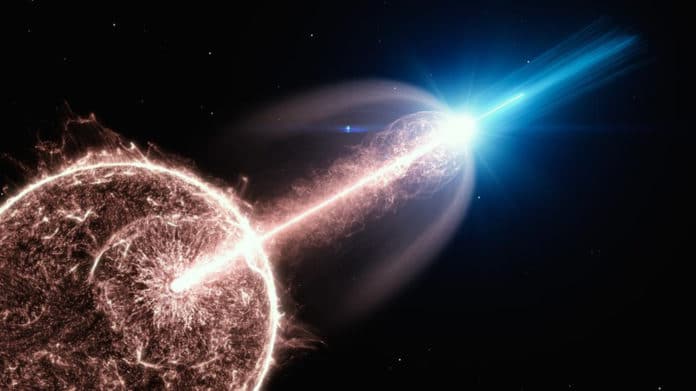Gamma rays in the universe are associated with the collapse of a rapidly rotating massive star to a black hole. They are categorized into two distinct phases: an initial chaotic prompt phase lasting tens of seconds and a long-lasting, smoothly fading afterglow phase.
Recently by using a specialized observatory in Namibia, scientists have witnessed the most energetic radiation and the longest gamma-ray afterglow of a so-called gamma-ray burst (GRB) to date. The event, dubbed GRB 190829A, became one of the nearest gamma-ray bursts observed so far, with a distance of about one billion light-years.
Fermi and Swift detected the event on 29 August 2019 in the constellation of Eridanus. Scientists then immediately captured the afterglow of the explosion when it became visible to the H.E.S.S. telescopes. This afterglow was visible for several days and to unprecedented gamma-ray energies.
Co-author Edna Ruiz-Velasco from the Max Planck Institute for Nuclear Physics in Heidelberg said, “We could determine GRB 190829A’s spectrum up to an energy of 3.3 tera-electronvolts, that’s about a trillion times as energetic as the photons of visible light. This is what’s so exceptional about this gamma-ray burst—it happened in our cosmic backyard where the very-high-energy photons were not absorbed in collisions with background light on their way to Earth, as it happens over larger distances in the cosmos.”
After following the afterglow for more than three days, scientists found surprising similarities between the X-ray and very-high-energy gamma-ray emission of the burst’s afterglow.
D.E.S.Y. scientist Sylvia Zhu, one of the authors of the paper, said, “Established theories assume that separate mechanisms must produce the two emission components: the X-ray component originates from ultra-fast electrons that are reflected in the strong magnetic fields of the burst’s surroundings. This synchrotron” process is quite similar to how particle accelerators on Earth produce bright X-rays for scientific investigations.”
Existing theories suggest that electrons in gamma-ray bursts collide with synchrotron photons and boost them to gamma-ray energies in a process dubbed synchrotron self-Compton.
But GRB 190829A’s afterglow observations now show that both components, X-ray and gamma-ray, faded in sync. Also, the gamma-ray spectrum matched an extrapolation of the X-ray spectrum. It means X-rays and very-high-energy gamma rays in this afterglow were produced by the same mechanism.
Co-author Dmitry Khangulyan from Rikkyo University in Tokyo said, “It is rather unexpected to observe such remarkably similar spectral and temporal characteristics in the X-ray and very-high-energy gamma-ray energy bands if the emission in these two energy ranges had different origins. This poses a challenge for the synchrotron self-Compton origin of the very-high-energy gamma-ray emission.”
H.E.S.S. spokesperson Stefan Wagner from Landessternwarte Heidelberg said, “Looking to the future, the prospects for the detection of gamma-ray bursts by next-generation instruments like the Cherenkov Telescope Array that is currently being built in the Chilean Andes and on the Canary Island of La Palma look promising. The general abundance of gamma-ray bursts leads us to expect that regular detections in the very-high-energy band will become rather common, helping us to understand their physics fully.”
Journal Reference:
- Revealing x-ray and gamma-ray temporal and spectral similarities in the GRB 190829A afterglow,” Science (2021). DOI: 10.1126/science.abe8560
